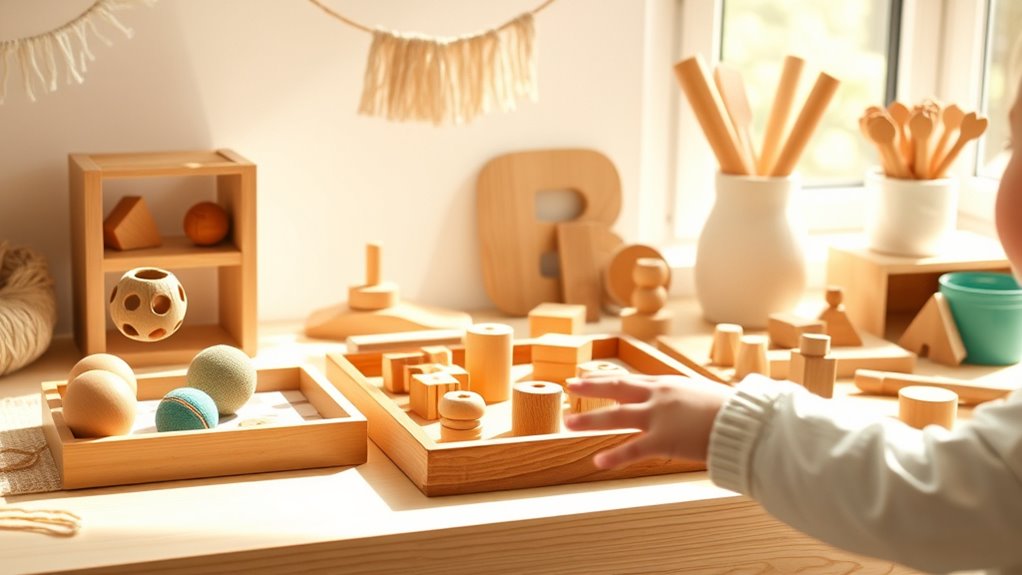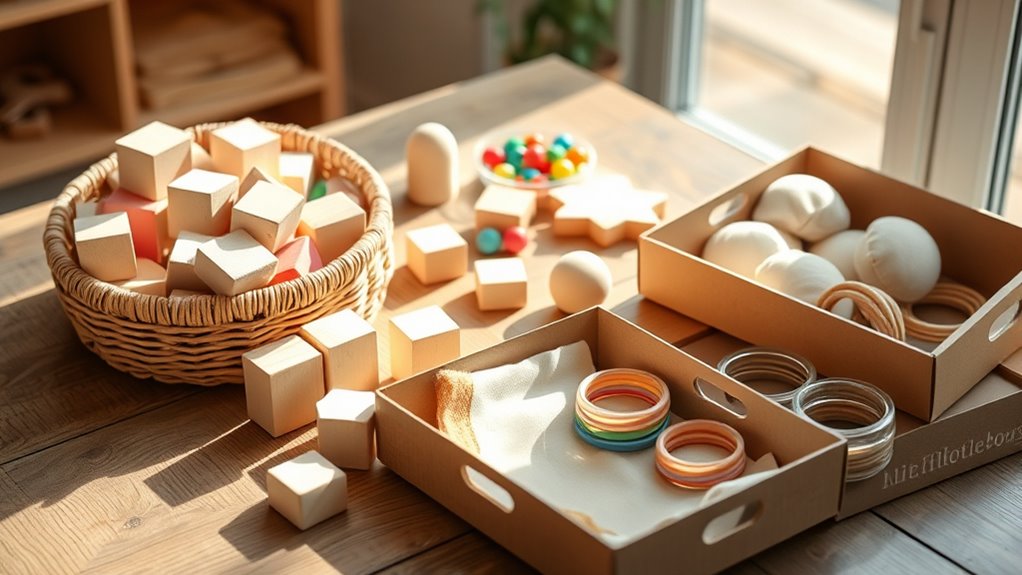Creating DIY Montessori toys on a budget is easy using everyday household items. Use jars, fabric scraps, and common objects like beans, rice, or pasta for sensory and practical life activities. Incorporate natural materials like wood or cotton for a tactile experience. Simple projects like pouring stations, color-matching games, or dressing frames promote independence and motor skills without spending much. Keep safety in mind, and discover more clever ideas to support your child’s development with what you already have.
Key Takeaways
- Use everyday household items like jars, fabric scraps, and household objects to create inexpensive Montessori toys.
- Fill containers with rice, beans, pasta, or sand for sensory activities without extra cost.
- Repurpose common items such as bottle caps and cardboard for color-matching and practical life activities.
- Incorporate natural materials like wood and cotton, which are affordable and enhance sensory development.
- Focus on simple activities that promote independence and fine motor skills using readily available, low-cost materials.

Have you ever wondered how to create engaging, educational toys for your child at home? One of the best ways is to focus on DIY Montessori toys that promote sensorial development and practical life skills. These toys don’t need to be expensive or complicated. Instead, they should encourage your child’s natural curiosity and independence through simple, hands-on activities. You can start by gathering everyday materials you already have around the house, like jars, fabric scraps, or household items. The goal is to design toys that stimulate your child’s senses—touch, sight, sound, taste, and smell—while also fostering their ability to perform practical life tasks.
For sensorial development, consider creating materials that allow your child to explore different textures and colors. For example, you can fill small bowls with items like rice, beans, pasta, or sand, and encourage your child to sort or transfer these using spoons or tongs. These activities refine their sense of touch, improve fine motor skills, and develop concentration. You can also make color-matching games with painted bottle caps or fabric swatches, helping your child distinguish shades and develop visual discrimination. Using natural materials like wood or cotton enhances the sensory experience and keeps the toys safe and eco-friendly.
Incorporating practical life skills into your DIY toys is equally crucial. You might create a simple pouring station with different-sized containers, allowing your child to practice hand-eye coordination and control. Using a shallow tray with water, beans, or beads can help improve their pouring and transferring skills—core components of practical life activities. You can also make dressing frames from cardboard and fabric, such as buttons, snaps, or zippers, which give your child the chance to practice dressing skills in a fun, stress-free way. These activities not only develop independence but also boost confidence as your child masters everyday tasks. Additionally, understanding the importance of motor skills development can help you select activities that support your child’s overall growth.
Frequently Asked Questions
What Are the Safest Materials for DIY Montessori Toys?
When choosing materials, prioritize safety by selecting non-toxic finishes and natural fibers. You want to avoid harmful chemicals that could pose health risks. Wooden toys with water-based or plant-based paints are ideal, as they’re safe and durable. Use natural fibers like cotton, wool, or hemp for soft textures. These materials are gentle, eco-friendly, and promote a healthy environment for your child, ensuring your DIY Montessori toys are both safe and engaging.
How Can I Customize Toys for Different Age Groups?
You might think toys are one-size-fits-all, but the truth is, age-specific activities make playtime smarter. To customize, use adaptation techniques like modifying difficulty levels or adding sensory elements. For younger kids, focus on simple, graspable objects. For older children, incorporate more complex tasks. By tailoring toys, you guarantee each stage sparks curiosity and development, proving that even DIY creations can grow with your child’s needs.
Are There Any Common Mistakes to Avoid?
When creating DIY Montessori toys, avoid common pitfalls like using unsafe materials or small parts that pose choking hazards. Always prioritize safety concerns by choosing non-toxic, durable supplies and supervising play. Don’t rush the process—planning and testing your toys guarantee they’re appropriate for the child’s age. Remember, simplicity is key; overly complicated designs can frustrate children and reduce developmental benefits. Stay attentive to safety and age-appropriateness to make the most of your DIY efforts.
How Do I Maintain and Clean Homemade Montessori Materials?
Maintaining and cleaning Montessori materials means mastering simple, consistent routines. You should regularly wipe surfaces with a damp cloth and mild soap, ensuring materials stay safe and shiny. Store supplies in smart storage solutions like labeled bins or baskets to prevent clutter and damage. By establishing easy cleaning routines and smart storage solutions, you protect your homemade treasures, keeping them pristine, inviting, and ready for your child’s curious explorations.
Where Can I Find Affordable Supplies and Resources?
You can find affordable supplies and resources at thrift store finds and online marketplaces. Thrift stores often have inexpensive, quality items perfect for creating Montessori materials, while online platforms like eBay or Etsy offer a wide range of new and used supplies at lower prices. By exploring these options, you’ll discover budget-friendly materials that support your Montessori approach without overspending, making it easier to create engaging learning tools for your child.
Conclusion
By creating your own Montessori toys on a budget, you’re planting seeds of curiosity and independence in your child’s mind. Each simple material becomes a symbol of trust and exploration, nurturing their innate desire to learn. Remember, it’s not about perfect toys but the love and intention behind them. As they grow, these humble tools will serve as guiding stars, illuminating their path toward confidence and lifelong discovery. Your thoughtful creations truly shape their brightest future.











